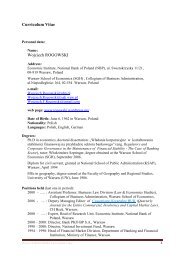EMERGING
Emerging Markets:
Emerging Markets:
Create successful ePaper yourself
Turn your PDF publications into a flip-book with our unique Google optimized e-Paper software.
<strong>EMERGING</strong> MARKETS:<br />
A Review of Business and Legal Issues<br />
The German model of corporate governance<br />
Although German economy is one of the most important in the world, its corporate<br />
governance, which has been developing at least since the industrial revolution, was analysed<br />
relatively late. 1<br />
The classic German model of management and corporate governance<br />
(ordnungsgemäße Unternehmensführung) and its environment consists of, inter alia,<br />
perceiving the enterprise as a social institution, supervisory board separate from the Board of<br />
Directors, significant participation in the supervisory board of employee representatives (from<br />
33% to 50% of its composition) and bank representatives, large blocks of shares and family<br />
ownership in listed companies, large impact of banks on the management of the company by<br />
means of crediting, trusteeship of voices and/or ownership of blocks of company shares,<br />
intersecting capital and personal links between companies and political establishment (the socalled<br />
Deutschland AG symptom), as well as relatively low capitalisation of the stock<br />
exchange (as compared to the GDP), lesser role of investment funds and of the acquistions<br />
market. 2 The case of Siemens illustrates the German model but also provides a lot of evidence<br />
confirming the evolution of the German corporate system. 3 Although the founder’s family<br />
remains the largest shareholder, it is not the shareholders that decided about the events which<br />
took place in the last year, but a group of managers who are members of the supervisory<br />
board. Although the representatives of employees and trade unions still dominate the<br />
supervisory board, the dispersed structure of Siemens shareholders, with a large share of<br />
institutional investors, already reminds of the companies of the American model, though the<br />
percentage of shares represented at the general shareholders’ meeting is much higher than in<br />
the US.<br />
1 Inter alia Prowse S.:Corporate Governance In an International Perspektive. BIS Economic Papers No.41,<br />
1994,; K.J. Hopt et al.: Comparative Corporate Governance. Oxford 1998,: Clarendon, Boehmer E.:<br />
Corporate governance in Germany: Institutional background and empirical results (1999). [in:] Corporate<br />
governance and economic performance, ed. K. Gugler, Oxford University Press, Oxford 2002.<br />
2 Charkham J.P., H.Ploix: Keeping Better Company. Corporate Governance Ten Years On, Oxford University<br />
Press, Oxford 2005.<br />
3 Hackethal A., R.H. Schmidt, M.: Tyrell Banks and German Corporate Governance: on the way to a capital<br />
market-based system? Corporate Governance: An International Review Vol. 13 Issue 3, 2005, p. 397<br />
Page 43 Volume 1, April 2009




